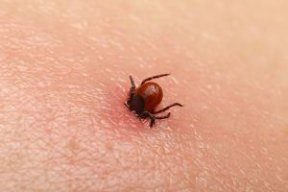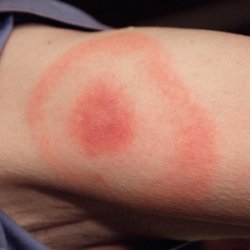
Just found a tick on your skin? Don’t panic. It usually takes about 36 hours for it to adhere, feed, and transfer the bacteria that causes Lyme disease. Meaning: If you remove it during that period, it likely hasn’t had a chance to infect you. Here’s how to get that sucker off safely and what to do next.
Remove
Using fine-tipped tweezers, grab the tick as close as you can to where it’s attached to your skin and pull directly upward with even pressure. Twisting or jerking can cause the mouthparts to break off and remain in the skin. (If any mouthparts are left behind, leave them alone; they’re icky but harmless, and like a splinter, they’ll work their way out on their own.) Disinfect the bite and your hands with rubbing alcohol or soap and water.
Check
If you find one tick, you may have more, so do a full-body exam. Use a handheld or full-length mirror, paying attention to the back of your knees, scalp, armpits, and even between your butt cheeks and genitals.

Optional: Confirm
Take a picture and upload it to the University of Rhode Island’s TickSpotters.org, especially if it looks like the tick had time to feed. In about 24 hours, their pros will reply (at no cost), identifying your tick, and based on your location, assess the riskiness of your bite. For extra assurance, attach the tick to an index card with clear tape, or submerse it in rubbing alcohol to kill it, then place into a sealed plastic baggie. Mail it to TickReport, a nonprofit organization at UMass Amherst. For about $50, they’ll test your tick and e-mail you a report within three business days about any bacteria and viruses it’s carrying. If either test suggests Lyme, get to your doctor ASAP.
Monitor
Rash or flu-like symptoms—low-grade fever, aches, chills, and fatigue—can occur up to a month after being bitten. If you feel them, hightail it to your doc, even if you just know you may have been exposed but don’t remember being bitten (70 percent of people with Lyme don’t). An M.D. can do a visual exam or blood test to check for the disease. It can take a few weeks for the illness to show up in your blood, so if you test negative and still feel sick, and consider retesting or a second opinion.
You Got Lyme. Now What?
Most people recover with a course of antibiotics (the sooner you take them, the better). But up to 20 percent of patients have lingering issues like fatigue and muscle and joint pain that can last for six months or longer, a condition called post-treatment Lyme disease syndrome (PTLDS). Experts aren’t sure what causes PTLDS, but if you have been treated and still feel unwell, see your M.D., who can prescribe meds and behavioral therapies to help you cope.












